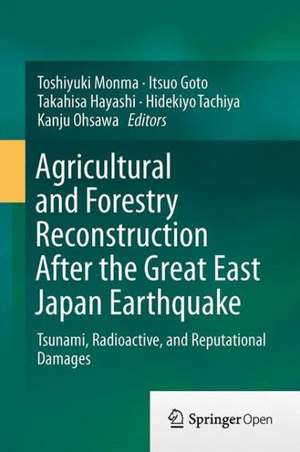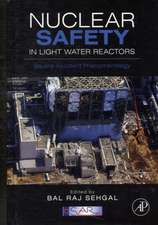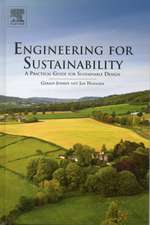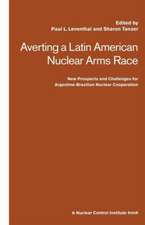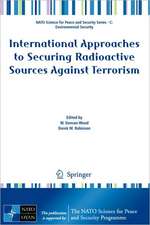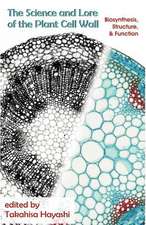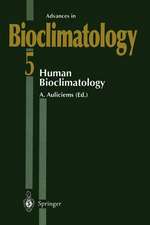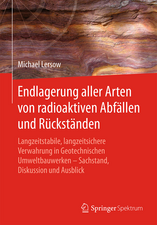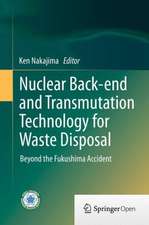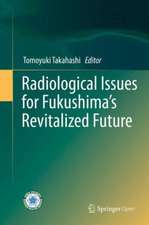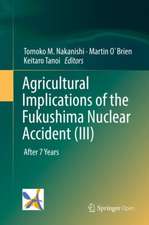Agricultural and Forestry Reconstruction After the Great East Japan Earthquake: Tsunami, Radioactive, and Reputational Damages
Editat de Toshiyuki Monma, Itsuo Goto, Takahisa Hayashi, Hidekiyo Tachiya, Kanju Ohsawaen Limba Engleză Hardback – 24 aug 2015
| Toate formatele și edițiile | Preț | Express |
|---|---|---|
| Paperback (1) | 366.16 lei 38-44 zile | |
| Springer – 22 oct 2016 | 366.16 lei 38-44 zile | |
| Hardback (1) | 390.57 lei 38-44 zile | |
| Springer – 24 aug 2015 | 390.57 lei 38-44 zile |
Preț: 390.57 lei
Nou
Puncte Express: 586
Preț estimativ în valută:
74.76€ • 81.23$ • 62.84£
74.76€ • 81.23$ • 62.84£
Carte tipărită la comandă
Livrare economică 17-23 aprilie
Preluare comenzi: 021 569.72.76
Specificații
ISBN-13: 9784431555575
ISBN-10: 4431555579
Pagini: 260
Ilustrații: XVII, 264 p. 141 illus., 65 illus. in color.
Dimensiuni: 155 x 235 x 22 mm
Greutate: 0.69 kg
Ediția:1st ed. 2015
Editura: Springer
Colecția Springer
Locul publicării:Tokyo, Japan
ISBN-10: 4431555579
Pagini: 260
Ilustrații: XVII, 264 p. 141 illus., 65 illus. in color.
Dimensiuni: 155 x 235 x 22 mm
Greutate: 0.69 kg
Ediția:1st ed. 2015
Editura: Springer
Colecția Springer
Locul publicării:Tokyo, Japan
Public țintă
ResearchCuprins
Part I The Road to Reconstruction from the Tsunami and Radioactive Contamination: Two and a Half Years On.- 1 Dealing with Disasters of Unprecedented Magnitude: The Local Government’s Tribulations and the Road to Reconstruction (Hidekiyo Tachiya).- 2 Tokyo University of Agriculture East Japan Assistance Project Assisting with Reconstruction: Guiding Principles, Planning, and Propagation of Benefits (Toshiyuki Monma).- 3 Characteristics of the Agricultural and Forestry Industries in the Soma Area and Damage Sustained as a Result of the Great East Japan Earthquake (Takahiro Yamada, Puangkaew Lurhathaiopath, and Toshiyuki Monma).- Part II Reconstruction from Tsunami Damage.- 4 Reconstruction Support for the Farmland Struck by Tsunami (Itsuo Goto and Kaisei Inagaki).- 5 Tsunami Damage to Farming Operations and the New Generation of Farmers and Farm Management (Yukio Shibuya, Takahiro Yamada, Nyamkhuu Batdelger, Puangkaew Lurhathaiopath, Gentaro Suzumura, and Toshiyuki Monma).- 6 Presenting a Model for Revival of Rural Communities in Japan’s Disaster Zones (Shigeyuki Miyabayashi, Yasushi Takeuchi, Hiromu Okazawa, Tomonori Fujikawa, and Yutaka Sasaki).- 7 Contributing to Restoration of Tidal Flats in Miyagi Prefecture’s Moune Bay Following the Great East Japan Earthquake and Tsunami (Susumu Chiba, Takeshi Sonoda, Makoto Hatakeyama, and Katsuhide Yokoyama).- Part III Reconstruction from Radioactive Contamination.- 8 Initiatives by the Soil Fertilization Team to Develop Agricultural Technologies for Paddy Fields with Radioactive Contamination (Itsuo Goto and Kaisei Inagaki).- 9 The Potential for Producing Rice for Feed and Whole Crop Rice Silage in Radiation-Contaminated Areas (Seiji Nobuoka).- 10 Developing and Trialing a System to Monitor Radionuclide in Individual Plots of Farmland to Help Reconstruction Farming in Contaminated Areas (Toshiyuki Monma, Puangkaew Lurhathaiopath, Youichi Kawano, Dambii Byambasuren, Yuta Ono, and Quar Evine).- 11 New Decontamination Methods for Parks and Other Areas in Which Radionuclide Have Accumulated (Mitsuo Kondo and Chizuko Mizuniwa).- 12 Forest Restoration (Takahisa Hayashi).- 13 Nuclear Radiation Levels in the Forest at Minamisoma, Fukushima Prefecture (Iwao Uehara, Tomoko Seyama, Fumio Eguchi, Ryuichi Tachibana, Yukito Nakamura, and Hiroya Obayashi ).- 14 Radioactive Contamination of Ostriches in a Potentially Permanent Evacuation Zone (Hiroshi Ogawa, Hidehiko Uchiyama, Koji Masuda, Takeshi Sasaki, Tadao Watanabe, Toshiaki Tomizawa, and Schu Kawashima).- 15 The Radioactive Contamination in Some Arthropod Species in Fukushima (Tarô Adati and Sota Tanaka).- 16 A Consumer Survey Approach to Reputation-Based Damage Affecting Agricultural Products and How to Overcome It (Puangkaew Lurhathaiopath, Shizuka Matsumoto, Makoto Hoshi, Sayaka Yamaguchi, and Toshiyuki Monma).- Part IV Activities and Impressions of Students and Farmers Who Supported the Project.- 17 Staking Recovery Hopes on Soma Revival Rice (Kaisei Inagaki, Tomoko Ninagi, Saburo Sasaki, and Akiko Sato).- 18 Impression of the Students Participated in the Radioactivity Monitoring System of Farmland (Volodymyr Ganzha, Keiji Kanamori, Hana Fujimoto, and Ryo Itakura).- 19 Impression of the Forestry managers and students participated in the Radioactivity Damage Investigation of Forests (Eihachi Horiuchi, Kiyoaki Sasaki, Masaaki Itakura, Chisato Yasukawa, and Chihiro Kinoshita).
Textul de pe ultima copertă
This book summarizes the results of 3 years of agricultural and forestry reconstructive efforts and applied research conducted directly in the affected areas of Fukushima following the Great East Japan Earthquake. It describes fast and effective revival methods and technologies from tsunami and radiation damages, demonstrated through the collaborative efforts of researchers, students, local farmers, forest owners, and municipalities gathered under the Tokyo University of Agriculture East Japan Assistance Project. Consisting of four parts, the first part of the book provides an overview of the damage and measures taken to overcome them by the local municipalities and the Tokyo University of Agriculture. The second part presents data and results of agricultural recovery from the tsunami—for example, monitoring systems, reconstruction models, and convenient, low-cost methods developed for the restoration of tsunami-damaged paddy fields. The third part focuses on recovery from radiation-contaminated farmlands and forests and consequent reputational damages. Included are various primary data obtained from field experiments and surveys, studies on the mechanism of contamination, and the results of radical monitoring, decontamination, and restoration techniques performed at this site. The final part is a collection of reflections of local farmers, forest owners, and students who participated in the project. The academic trials and errors recorded in this book are an invaluable contribution to disaster management and recovery processes. It is written for a wide audience, not limited to researchers and students, but also for government and state officials, municipalities, agricultural cooperative staff members, and farmers.
Caracteristici
Addresses holistically the tsunami, radioactive, and reputational damages of the Great East Japan Earthquake
Includes contributions from not only researchers, but also municipal officials, local farmers, forest owners, and students
Contains primary data obtained from on-site experiments
Presents new technologies and methods developed to restore and monitor fields and forests
Includes contributions from not only researchers, but also municipal officials, local farmers, forest owners, and students
Contains primary data obtained from on-site experiments
Presents new technologies and methods developed to restore and monitor fields and forests
